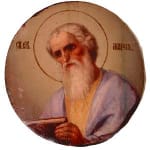Saint Mark, 19th Century CE
Oil on Wood Panel
11
PF.5836
Further images
Russians inherited the tradition of icon painting from Byzantium, where it began as an offshoot of the mosaic and fresco tradition. During the 8th and 9th centuries, the iconoclastic controversy...
Russians inherited the tradition of icon painting from Byzantium, where it began as an offshoot of the mosaic and fresco tradition. During the 8th and 9th centuries, the iconoclastic controversy in the Orthodox Church called into question whether religious images were a legitimate practice or sacrilegious idolatry. Although the use of images was in the end permitted, a thorough distinction between profane art intended to depict reality and sacred art designed for spiritual contemplation was established. That difference is one of the reasons that the artistic style of icons can seem so invariant. Certain kinds of balance and harmony became established as reflections of divinity, and as such they invited careful reproduction and subtle refinement rather than striking novelty. Although this philosophy resulted in a comparatively slow evolution of style, icon painting evolved considerably over the centuries. Unlike the pictorial traditions of the west that aspire towards increased realism and naturalism, the essence of Russian icon painting is not about the representation of physical space or appearance. Icons are images intended to aid in contemplative prayer, and in that sense, are more concerned with conveying meditative harmony than with laying out a realistic scene. They were not painted to please the eye of the mind, but to inspire reflection and self-examination.
St. Mark is the traditional author of the second Synoptic Gospel. Data on his life found in the New Testament are fragmentary, and most of their historical authenticity has been questioned by critical investigation. According to Acts, his mother's house in Jerusalem was a center of Christian life, and he accompanied Barnabas and Paul to Antioch where he became their assistant on a mission journey. When they arrived at Perga, Mark left them and returned to Jerusalem. Mark's leaving caused Barnabas and Paul to separate, for Paul declined Barnabas' insistence on giving Mark another chance. Subsequently, Mark sailed to Cyprus with Barnabas, never to be mentioned again in Acts. The dependability of the Acts account is questionable, for its author is particularly interested in explaining the breach between Paul and Barnabas, probably only introducing Mark for this reason. The Egyptian church claims Mark as its founder, and, from the 4th century A.D., the see of Alexandria has been called cathedra Marci (“the chair of Mark”). Other places attributing their origin to Mark are the Italian cities of Aquileia and Venice, of which he is the patron saint. His symbol is the lion.
Warmth radiates from within this stunning painting. The light, pastel hues of Mark’s robes and the pale greenish background add to this effect. However, this feeling is derived from more than just the composition and tones. Instead the love and honor the artist must have felt for this holy figure has penetrated the work. The soft, gentle nature of the Saint is evident in his large, open eyes and facial features. He appears as the elder grandfather who comforted us as a child. There is also an intense, pensive reflection in his eyes as he concentrates upon the book he holds in his hands, presumably his own account on the life of Christ. This icon succeeds where many other religious works fail: it effectively creates the aura of an individual who is both approachable and sympathetic, and yet holy and worthy of our veneration. Thus, as we gaze upon this image, we are drawn to the figure and yet in awe of him at the same time.
St. Mark is the traditional author of the second Synoptic Gospel. Data on his life found in the New Testament are fragmentary, and most of their historical authenticity has been questioned by critical investigation. According to Acts, his mother's house in Jerusalem was a center of Christian life, and he accompanied Barnabas and Paul to Antioch where he became their assistant on a mission journey. When they arrived at Perga, Mark left them and returned to Jerusalem. Mark's leaving caused Barnabas and Paul to separate, for Paul declined Barnabas' insistence on giving Mark another chance. Subsequently, Mark sailed to Cyprus with Barnabas, never to be mentioned again in Acts. The dependability of the Acts account is questionable, for its author is particularly interested in explaining the breach between Paul and Barnabas, probably only introducing Mark for this reason. The Egyptian church claims Mark as its founder, and, from the 4th century A.D., the see of Alexandria has been called cathedra Marci (“the chair of Mark”). Other places attributing their origin to Mark are the Italian cities of Aquileia and Venice, of which he is the patron saint. His symbol is the lion.
Warmth radiates from within this stunning painting. The light, pastel hues of Mark’s robes and the pale greenish background add to this effect. However, this feeling is derived from more than just the composition and tones. Instead the love and honor the artist must have felt for this holy figure has penetrated the work. The soft, gentle nature of the Saint is evident in his large, open eyes and facial features. He appears as the elder grandfather who comforted us as a child. There is also an intense, pensive reflection in his eyes as he concentrates upon the book he holds in his hands, presumably his own account on the life of Christ. This icon succeeds where many other religious works fail: it effectively creates the aura of an individual who is both approachable and sympathetic, and yet holy and worthy of our veneration. Thus, as we gaze upon this image, we are drawn to the figure and yet in awe of him at the same time.







